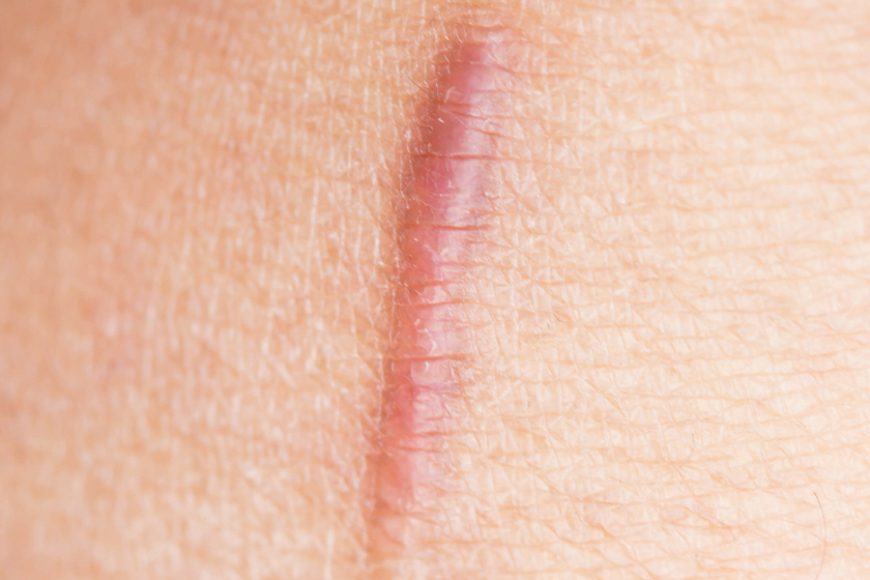In the annals of human development, the body’s ability to form scars was an evolutionary breakthrough — its means of surviving life-threatening skin wounds. But in the modern world, scars can be barriers to optimal health, bringing distress and discomfort, especially if the scar is large or prominent or inhibits movement.
The process may appear simple: Following a serious wound — due to accident, surgery, acne or disease — our skin goes through a healing process that gradually reveals a new surface — sometimes raised, sometimes pitted, often redder than the surrounding area. Scars are patches that our body creates as quickly as possible for protection. But our system’s focus on a fast fix means that the rebuild lacks our skin’s original structures and appearance. The result can be distressing. And large scars — especially in the case of burns — can interfere with movement, in particular if the scarred area affects joints.
On its surface, scar formation may seem straightforward, but researchers today are uncovering complex processes that cooperate to allow our skin to repair itself. The body orchestrates a cascade of interrelated cellular responders that coordinate to avoid infection and rebuild. Recent research is giving us a more nuanced understanding of the processes in play — which offers exciting possibilities for treating scars.
With that in mind, I make the following observations:
• Wound “tension” plays an even bigger role: We’ve known that relaxing tension across a wound is essential to minimizing scarring. But we’re getting a better understanding of just how significant tension-reducing dressings and surgical techniques can be. New research shows that tension triggers biochemical responses that cause additional scar tissue to form. New ways of dressing wounds — like the embrace device which continuously reduces strain on the tissue — and specialized surgical techniques for scar removal can encourage healthy skin renewal and lessen scar formation.
• For laser repair, get on the right wavelength: Lasers offer a dual means of minimizing scars. They can redesign the scar’s “fast fix” by reorganizing collagen to improve the surface. They also can reduce the inflammation and blood vessels that give some scars a red appearance. We know that using the correct wavelength — whether via a CO2 laser, Nd-YAG, or Fraxel — is key to the desired outcome, whether it’s evening the surface or the pigment.
• New treatments can help our skin help itself: For large scars, especially due to burns, we’re seeing breakthroughs that can reduce extensive skin grafts. Skin-cell research has resulted in treatments such as the recently FDA-approved “ReCell,” where doctors take a small section of the patient’s healthy skin and break it down into its component cells: fibroblasts, keratinocytes, melanocytes. Those cells are then used to formulate a spray-on skin treatment that can repopulate a much, much larger surface area.
• Retuning the body’s responses may build new skin: Today’s research offers a entryway to healthy skin regeneration. We have an understanding of the cellular processes involved in the body’s response to wounds. Some cellular responses trigger scarring; others increase healthy skin renewal, with normal structures such as hair follicles and glands. If we can “turn off” the scarring stimuli and “turn on” regeneration processes, we can take a major step forward in scarless healing. We offer patients advanced Microneedling Treatments, including the collagen pin and Intensif, which help tremendously with scars and anti-aging.
• Specialized superhealers come to the rescue: In certain cases serious wounds heal with no scars: Fetal surgeries show scarless healing. Likewise wounds inside our mouths. Certain animals also offer models: The covering on a reindeer’s antlers — remarkably similar to human skin — can rebuild itself. Identifying the unique cellular characteristics involved in these examples provides clues to promoting new skin rather than scarring.
The research happening now offers the possibility of building on evolution’s solution to skin damage, replacing scarring with actual renewal.
Jie Chen, RPA-C is a certified physician assistant, through the National Commission of Certification of Physician Assistants, with Advanced Dermatology PC and the Center for Laser and Cosmetic Surgery (New York & New Jersey).
For more, visit advanceddermatologypc.com.

